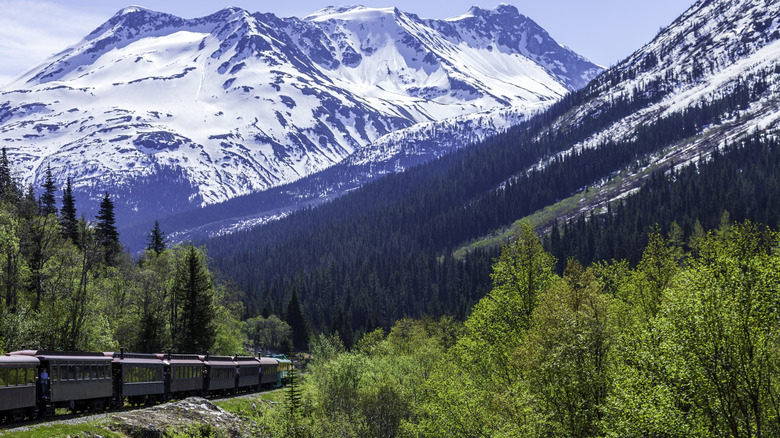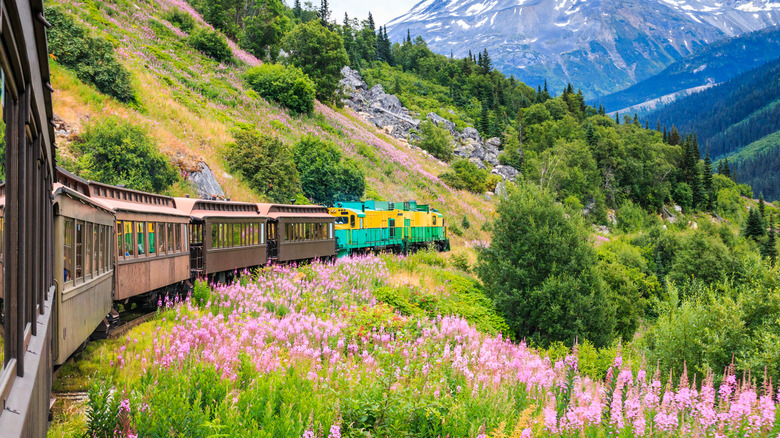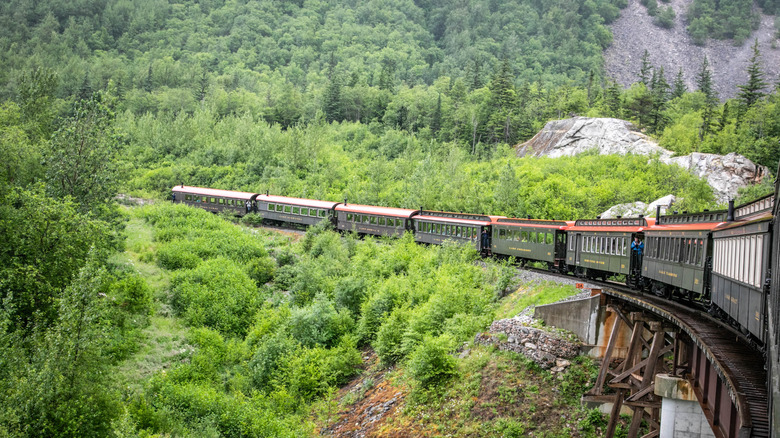The 'Scenic Railway Of The World' Is A Historic Trek Through The Breathtaking Alaskan Wilderness
At the far end of civilization, America's immense and untamed northern frontier only accepts the hardiest of adventurers. The 49th state's 663,000 square miles of wilderness are intimidating to travelers, an unfathomable expanse of snow-drenched mountains and impenetrable forests. Travelers on foot face ferocious wildlife and challenging trails, drivers are impeded by the limited roads, and cruisers miss the astonishing Alaskan interior. The natural solution, it would seem, is train travel.
Several scenic rail routes cut through the boundless Alaskan interior, transporting travelers on one of the most breathtaking train rides in America. Among them is a gold rush line, a rail trail that follows in the footsteps of the eager-eyed miners whose thirst for riches propelled them into the unknown Alaskan wilds. The White Pass and Yukon Route Railroad snakes into the heart of the Yukon, a short-haul narrow-gauge train that trundles over natural wonders.
Given that the journey can be as short as just over two and a half hours, it can be tacked on as a day trip to a wider Alaskan itinerary. An afternoon spent whiling by the train window is only a 20-minute detour away for travelers tackling one of the north's most spectacular drives, a legendary Alaskan road with eerie seclusion and beauty. You don't have to embark on an epic adventure to get there, though. The trains' point of origin, the small town of Skagway, is accessible by car via the South Klondike Highway and by air on scheduled and charter air services from Juneau and Haines.
Cruise past mountains, waterfalls, gorges, and glaciers on the White Pass and Yukon Route railroad
Ascending 3,000-feet over the Alaskan wilderness, nabbing a window seat on the White Pass and Yukon Route Railroad gives you a front row vantage over glacial waterways that slither through valleys swathed in wildflowers. It lets you watch the waterfalls' crashing crescendos and wraps you around the White Pass summit. Few railroads on earth trundle through such pristine scenes, almost entirely undisturbed by humans and more than a thousand miles from the next concrete metropolis.
Settled within the train's sumptuous, old-world interior, the Skagway Harbor will slip into the distance as you climb into the frost-slicked Sawtooth Range. Shadowed by serrated crag, you'll have to keep an eye out for the age-blanched bones of gold-rush companions, frozen in their graves in Dead Horse Gulch. From there, the train will mount the summit and you'll get your first glorious view of the mouth of the mighty Yukon River.
While the under three-hour journey option doesn't travel further, there are several packages that travelers can book which pair the White Pass and Yukon Route Railroad with extra adventures. As Alaska provides scenic, diverse landscapes for endless outdoor adventure, it makes sense to continue your voyage into the wildest US state. You can purchase an onwards ticket to embark on the Bennett Scenic Journey, which travels another 67.5 miles towards Carcross' cobalt lakes. Choose to head back to Skagway from the Canadian town's turn-of-the-century station or take your time hiking and biking in Carcross before taking a return train another day.
Learn the history of the Alaskan Gold Rush from your train seat
Some 100,000 prospectors packed up their picks and set out for the Yukon between 1896 and 1899. Only about 30,000 made it. A frantic hoard of gold-hungry workers flooded the northern Canadian province, making their way up through Alaska's easternmost strip. Rich men set sail and skimmed the coast in sailboats, poor men had an extra two years added to their journey on the overland route. Attempting to scale glaciers, survive ice-slicked mountain passes, and hike some 500 miles by the riverside, it quickly became apparent that an alternative mode of transport was essential.
In 1898, the White Pass and Yukon Route Railway began construction. For two years, two months, and two days, 35,000 rotating workers labored to create a non-life-threatening passage to the north. They would lay hundreds of tons of dynamite to blast a tenable path through the rocks, constructing tunnels and trestles through the blistering climes of the Alaskan winter. As you ride over those same rails, still standing strong more than 120 years later, you'll be able to see tangible proof of the grit of those engineers and laboring crews reflected in the snowbanks and steep cliffs that surround the train on all sides. Before embarking, stop into Skagway's Klondike Gold Rush National Historical Park to immerse yourself in the world of the stampeders before seeing their perilous trail for yourself.


